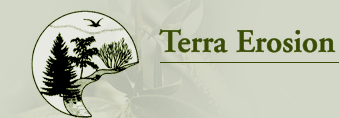Stormwater
Outfall Rehabilitation
OUTFALL
101
Go To: Monitoring 2009
Location:
Terwillegar
Park, along bank of North Saskatchewan River in Edmonton,
Alberta
Client:
City
of Edmonton
Objective:
To
protect the infrastructure of storm water outfall 101
by stabilizing the riverbank using vegetated riprap.
Creation of fish and wildlife habitat values, through
incorporation of vegetation within the riprap, using
soil bioengineering techniques. Vegetation establishment
on sloped area above riprap installation.
During
the summer of 2008 Stantec Consulting contacted Terra
Erosion Control (TEC) regarding riverbank erosion problems
at storm water outfall #101, which discharges into the
North Saskatchewan River . A field visit and assessment
was carried out during that summer. The riverbank erosion
appeared to have been caused by fluctuating water levels
and the melting of the ice on the river over years,
which undermined the toe of the slope on either side
of the outfall structure resulting in shallow slope
failures.
In
September of 2008 TEC was retained in conjunction with
Kitchton Contracting of Edmonton to implement a vegetated
riprap design developed by Jason McDiarmid CET of Stantec
Consulting. The drawing was based on a design developed
by TEC on storm water outfall 56 implemented during
the fall of 2007. The design also included long live
staking (3 to 4 m) to be placed within and in front
of the toe of riprap. The exposed ends of these long
live stakes are intended to be above high water level
to provide additional fish habitat.
The
work was implemented in October and November of 2008.
The soil bioengineering structures were constructed
using locally harvested live materials of willow (Salix
bebbiana / exigua / scouleriana) , black cottonwood
(Populus balsamifera ssp. trichocarpa) and
red-osier dogwood (Cornus stolonifera).
Live
cuttings were installed within the riprap concurrent
with rock placement using a walking excavator or spyder
hoe. Wooden boards/plywood sheets were used to protect
the cuttings as riprap was placed on the slope. Insertion
of long live stakes within and in front of the toe of
riprap was machine-assisted with the spyder hoe using
a wooden stinger to poke holes for insertion of the
live stakes.
Contour
fascines were installed above the vegetated riprap.
Top soil was placed on disturbed areas and the site
was broadcast seeded with a native grass mix and planted
with native rose and alder seedlings (Rosa acicularis,
Alnus tenuifolia).
Due
to very low water levels on the North Saskatchewan River
at the time of implementation, no turbidity curtain
was installed in the river. In accordance with the Department
of Fisheries and Oceans regulations a sediment barrier
was installed in front of the project area. This barrier
was constructed of straw bales and silt fencing to reduce
sediment delivery to the river. Straw wattles
and silt fencing were also installed on the slope to
act as sediment traps. |



